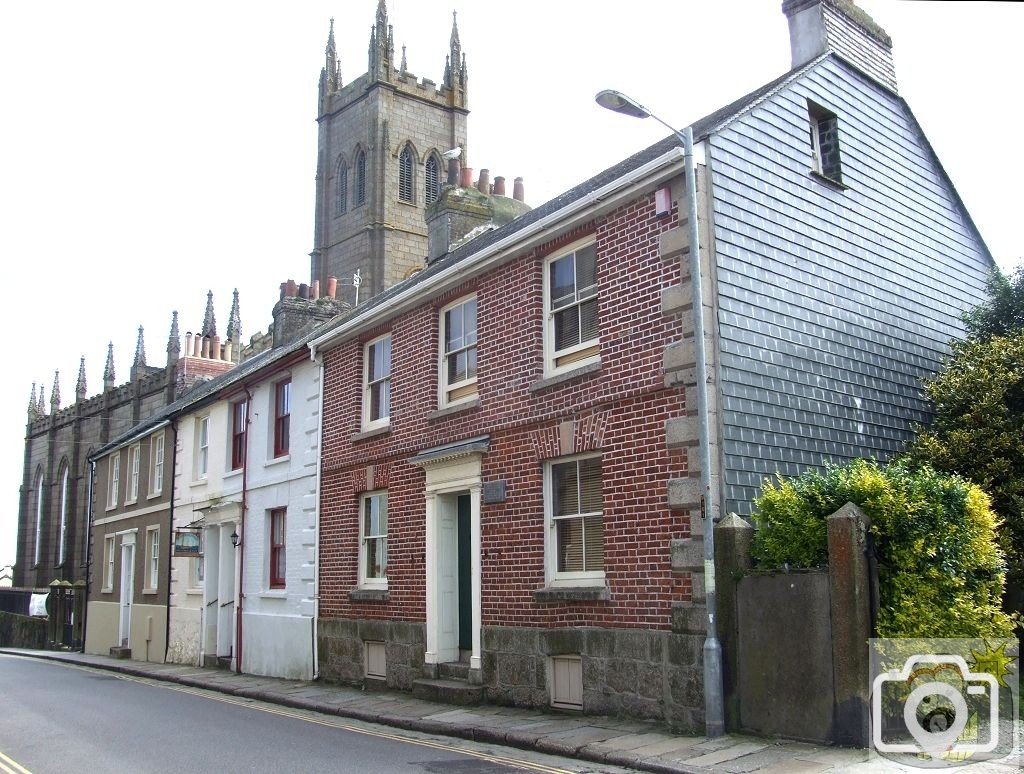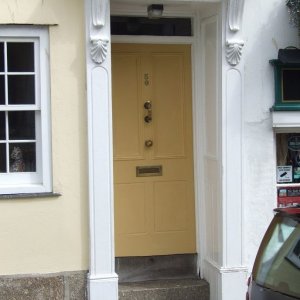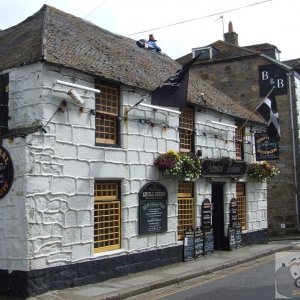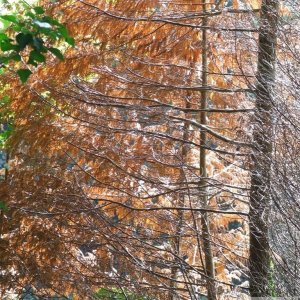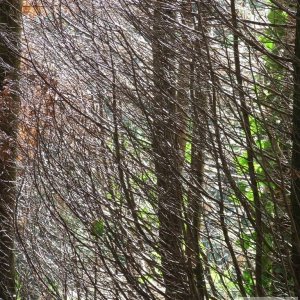You are using an out of date browser. It may not display this or other websites correctly.
You should upgrade or use an alternative browser.
You should upgrade or use an alternative browser.
I make no apologies for the amount of text above. It is time that certain details were clarified about these lovely buildings and their occupants, in the development of what was to become Chapel Street.
Nrs 25-28, Chapel Street, Penzance
Up the road in Chapel Street,
Richard Oxnam's brick house was built in 1734 for his grandfather, also Richard Oxnam, also merchant;
it is built over an earlier granite building, the basement level is quite different in character.
Bricks were often brought over from Holland, as ballast.
There were later shipments of brick brought over, as they were seen to be more luxurious than granite walls.
Chapel Street includes other old brick buildings as does Parade Street.
A few brief words on the name of Chapel Street …
Before the street that is seen today was begun, it was a bare narrow back lane, with a handful of cottages,
leading down behind New Street, to the Quay area.
For centuries it had no name, but at the bottom was to be found St Anthony’s (St Raphael and St Gabriel) Chapel
and later St Mary’s Chapel.
When the street was being built from about 1770, it became known and named as Lady Street
until the time that St Mary’s Chapel was rebuilt, when it became Chapel Street,
as the chapel was a daughter to Madron Church.
The street was neither named for St Anthony’s Chapel, nor the later Weslyan Chapel.
On the opposite side of Chapel Street, then named Lady Street, stands a group of brick buildings, just up from the Church.
[The slate cladding is of very recent date, to protect the aging masonry.] The other walls of each of the properties are of granite.
The granite steps up to each house are each quite different,
that to Nr 28 had an iron railing set into a raised feature at each end of the step, an indicator of three different builders.
In 1842, the group is shown as three individual properties.
Looking at W Trounson’s drawing of the original St Mary’s Chapel in 1824, there were steps up to the Churchyard,
which ran in front of Nr 28 (as described by J S Courtney) and across to another set of steps leading down to Quay Street.
It is said that these houses were built of bricks which were being carried by Dutch ships and then captured by a privateer of Penzance,
hence the attributed name of Rotterdam Buildings.
The first point is that privateers were nothing better than legalized pirates and there were rules,
they only attacked pirate ships and ships of a foreign hostile nation;
At the time, of the building of these three properties, there was no war or conflict between Britain and The Netherlands.
There are two stories – one states the Rotterdam Buildings were erected with the cargo of a Prize vessel,
the other that they were built with funds received from the Prize Money of the captured Dutch ship.
Neither of these stories can be considered acceptable.
A captured ship had to be rendered to the Crown [The Admiralty Prize Court],
whereupon it was determined if it was to be Condemned as a Prize of War, the ship and contents sold to swell the coffers of the Crown.
For a neutral ship to have been captured and declared a Prize of War, it would have had to have been carrying contraband,
and that had to be determined in relation to the ship’s marque and its intended port of call;
For a Dutch ship to have headed for a British port carrying both bricks
and an illegal cargo of casks of genever (Geneva Spirit = Gin) would have been odd, dangerous for the ship and unbelievably stupid.
The capturing vessel and the crew simply could not seize the ship for their own;
Even if the ship and cargo had been Condemned as a Prize of War in a time of war,
the ship and its cargo would have had to have been purchased.
Of course, the crew would have received a reward for the capture, which was divided between them.
To clarify the term Prize of War, the word is taken from the French 'prise', to take;
in other words, an officially recognised taking of a ship under the terms of engagement;
We now use the word Prize as some form of recognition of achievement.
The centre building was obviously erected first, as can be seen from the arrangement of quoin stones,
as there would have been no need for centre quoin stones, if the whole block had been built all at the same time.
The houses are numbered 25,26,27 and 28.
The builder of Nr 25 Chapel Street is known;
Richard Branwell and his partner Edward Hamilton in 1767, for Thomas Branwell and daughter-in law Ann (nee Carne),
as a wedding present (other work included The Union Hotel Assembly Rooms in 1791, their last).
Nr 25 was the home of Thomas and Anne Branwell and one of their daughters was Maria Branwell,
to become mother of Anne, Branwell, Charlotte and Emily Bronte.
The house was empty by 1815.
Nr 28 was occupied from 1799 by another Branwell family - Thomas Branwell and Ann Branwell (nee Carne);
it is my suspicion that this house was built more in that time, due partly to its different character and masonry;
it is now rendered and pebbledashed.
The central houses (Nr 26 and Nr 27 – Rotterdam Buildings) are said to have been built in c1760.
J S Courtney states that one of these four houses was a Post Office owned by N Phillips,
and run by Mrs Phillips and a Miss Swain.
Since these names do not appear in the Census records from 1841 to 1891 at this end of Chapel Street,
this means the post office was functioning after 1825 and before 1840.
In 1841 Chapel Street, Ellen Swain, 35yrs, Postmistress, with her mother Sarah.
In 1844 it is recorded - Post Office, Chapel-street, Penzance, Ellen Catherine Swain, Post Mistress.
Ellen Swain born 30th September 1803 in Bristol, was daughter of Thomas and Sarah (nee Scriven);
Ellen Swain was postmistress in Penzance from 1825 until she resigned in 1864; she died in 1875 at Nr50, Chapel Street.
Her father was a RN Lieutenant who led a distinguished career.
I suspect that the Post Office 1825 – 1835 was in Nr 25, as the house would have been empty and in the hands of solicitors.
It is recorded that the post office moved for a short time to Alverton Terrace and then back into Chapel Street by the Turks Head before 1841.
So, the houses were built separately at different dates by different builders for different owners
and not with captured bricks nor bricks bought with prize money;
the two end houses were owned and occupied by members of the Branwell family
and Nr 27 had been occupied by Jane Branwell at one time.
Nr 28 Owned and occupied by
Robert Matthews Branwell (widower) married Jane Vivian of Camborne; 5th January 1820.
Robert died 1833. Jane died in 1853 age 65. Their children were
Richard Branwell who left home early on and became a Surgeon of Brighton
Jane Branwell born 1821 and remained single and became a Governess
Eliza Branwell born 1823 she married Richard Hosking and lived at Brook Cottage Madron
Lavinia Branwell born 1824 she married Francis J Cornish, a grocer and lived in Greenmarket.
Julia Branwell born 1827 and remained single.
Ellen Vivian Branwell was born 1829 she married in 1866 to Alfred W Warder MD;
She was poisoned by her husband and died at Brighton 1st July 1866.
By 1851 Jane and her children had moved to Nr 27, a smaller property.
Nr 25 Owned and occupied by
Thomas Branwell and Ann Carne married 28th November 1768
Thomas died 5th April 1808 age 62; Ann died 19th December 1809 aged 66
Said to have had 11 children, eight girls and three boys, seven of the children survived.
Benjamin Carne Branwell married Mary Batten 25th January 1799
Jane Branwell married John Fennel, 13th December 1790
Maria Branwell left Penzance in 1812 and married Patrick Bronte
Elizabeth Branwell left Penzance in 1820.
Charlotte Branwell married her cousin Joseph Branwell
Full details of the family on my website The Acorn Archive under
“Branwell’s Mill, The Branwells and The Brontes”
Later occupiers
Nr 25: Jane Eva 1841;
James Saundry Navigation Master, and his son Horatio Saundry, Printer and Bookbinder 1851;
Stephen Richards potato merchant 1861; Thomas Teague Schoolmaster 1871;
Richard T Holbrook Coal Merchant and Ship Broker 1881, 1891.
Nr 26: Richard Pearce Merchant 1841; Martin Magor Dentist 1851, 1861;
Richard Hill Ships’ carpenter 1871; Thomas Smith Master Mariner and Richard Hill 1881; Elizabeth Bryant widow 1891.
Nr 27: Nancy Thomas Lodging Housekeeper 1841; Jane Branwell Annuitant 1851;
John Tonkin Cocking Master Hat Manufacturer (employing 21 staff) 1861; Philip Calf Hill – Pilot and guests 1871;
Elizabeth Harry and her retired fisherman father Edward Harry 1881; James Price Telegraphic Clerk 1891.
Nr 28: Jane (nee Vivian) Branwell and children 1841; Mary Farquharson School Mistress 1851, 1861;
William N Bassett Tobacconist and Stationer 1871; James Berryman Auctioneer 1881; Mary A Pender of Tresco 1891.
Raymond Forward
Nrs 25-28, Chapel Street, Penzance
Up the road in Chapel Street,
Richard Oxnam's brick house was built in 1734 for his grandfather, also Richard Oxnam, also merchant;
it is built over an earlier granite building, the basement level is quite different in character.
Bricks were often brought over from Holland, as ballast.
There were later shipments of brick brought over, as they were seen to be more luxurious than granite walls.
Chapel Street includes other old brick buildings as does Parade Street.
A few brief words on the name of Chapel Street …
Before the street that is seen today was begun, it was a bare narrow back lane, with a handful of cottages,
leading down behind New Street, to the Quay area.
For centuries it had no name, but at the bottom was to be found St Anthony’s (St Raphael and St Gabriel) Chapel
and later St Mary’s Chapel.
When the street was being built from about 1770, it became known and named as Lady Street
until the time that St Mary’s Chapel was rebuilt, when it became Chapel Street,
as the chapel was a daughter to Madron Church.
The street was neither named for St Anthony’s Chapel, nor the later Weslyan Chapel.
On the opposite side of Chapel Street, then named Lady Street, stands a group of brick buildings, just up from the Church.
[The slate cladding is of very recent date, to protect the aging masonry.] The other walls of each of the properties are of granite.
The granite steps up to each house are each quite different,
that to Nr 28 had an iron railing set into a raised feature at each end of the step, an indicator of three different builders.
In 1842, the group is shown as three individual properties.
Looking at W Trounson’s drawing of the original St Mary’s Chapel in 1824, there were steps up to the Churchyard,
which ran in front of Nr 28 (as described by J S Courtney) and across to another set of steps leading down to Quay Street.
It is said that these houses were built of bricks which were being carried by Dutch ships and then captured by a privateer of Penzance,
hence the attributed name of Rotterdam Buildings.
The first point is that privateers were nothing better than legalized pirates and there were rules,
they only attacked pirate ships and ships of a foreign hostile nation;
At the time, of the building of these three properties, there was no war or conflict between Britain and The Netherlands.
There are two stories – one states the Rotterdam Buildings were erected with the cargo of a Prize vessel,
the other that they were built with funds received from the Prize Money of the captured Dutch ship.
Neither of these stories can be considered acceptable.
A captured ship had to be rendered to the Crown [The Admiralty Prize Court],
whereupon it was determined if it was to be Condemned as a Prize of War, the ship and contents sold to swell the coffers of the Crown.
For a neutral ship to have been captured and declared a Prize of War, it would have had to have been carrying contraband,
and that had to be determined in relation to the ship’s marque and its intended port of call;
For a Dutch ship to have headed for a British port carrying both bricks
and an illegal cargo of casks of genever (Geneva Spirit = Gin) would have been odd, dangerous for the ship and unbelievably stupid.
The capturing vessel and the crew simply could not seize the ship for their own;
Even if the ship and cargo had been Condemned as a Prize of War in a time of war,
the ship and its cargo would have had to have been purchased.
Of course, the crew would have received a reward for the capture, which was divided between them.
To clarify the term Prize of War, the word is taken from the French 'prise', to take;
in other words, an officially recognised taking of a ship under the terms of engagement;
We now use the word Prize as some form of recognition of achievement.
The centre building was obviously erected first, as can be seen from the arrangement of quoin stones,
as there would have been no need for centre quoin stones, if the whole block had been built all at the same time.
The houses are numbered 25,26,27 and 28.
The builder of Nr 25 Chapel Street is known;
Richard Branwell and his partner Edward Hamilton in 1767, for Thomas Branwell and daughter-in law Ann (nee Carne),
as a wedding present (other work included The Union Hotel Assembly Rooms in 1791, their last).
Nr 25 was the home of Thomas and Anne Branwell and one of their daughters was Maria Branwell,
to become mother of Anne, Branwell, Charlotte and Emily Bronte.
The house was empty by 1815.
Nr 28 was occupied from 1799 by another Branwell family - Thomas Branwell and Ann Branwell (nee Carne);
it is my suspicion that this house was built more in that time, due partly to its different character and masonry;
it is now rendered and pebbledashed.
The central houses (Nr 26 and Nr 27 – Rotterdam Buildings) are said to have been built in c1760.
J S Courtney states that one of these four houses was a Post Office owned by N Phillips,
and run by Mrs Phillips and a Miss Swain.
Since these names do not appear in the Census records from 1841 to 1891 at this end of Chapel Street,
this means the post office was functioning after 1825 and before 1840.
In 1841 Chapel Street, Ellen Swain, 35yrs, Postmistress, with her mother Sarah.
In 1844 it is recorded - Post Office, Chapel-street, Penzance, Ellen Catherine Swain, Post Mistress.
Ellen Swain born 30th September 1803 in Bristol, was daughter of Thomas and Sarah (nee Scriven);
Ellen Swain was postmistress in Penzance from 1825 until she resigned in 1864; she died in 1875 at Nr50, Chapel Street.
Her father was a RN Lieutenant who led a distinguished career.
I suspect that the Post Office 1825 – 1835 was in Nr 25, as the house would have been empty and in the hands of solicitors.
It is recorded that the post office moved for a short time to Alverton Terrace and then back into Chapel Street by the Turks Head before 1841.
So, the houses were built separately at different dates by different builders for different owners
and not with captured bricks nor bricks bought with prize money;
the two end houses were owned and occupied by members of the Branwell family
and Nr 27 had been occupied by Jane Branwell at one time.
Nr 28 Owned and occupied by
Robert Matthews Branwell (widower) married Jane Vivian of Camborne; 5th January 1820.
Robert died 1833. Jane died in 1853 age 65. Their children were
Richard Branwell who left home early on and became a Surgeon of Brighton
Jane Branwell born 1821 and remained single and became a Governess
Eliza Branwell born 1823 she married Richard Hosking and lived at Brook Cottage Madron
Lavinia Branwell born 1824 she married Francis J Cornish, a grocer and lived in Greenmarket.
Julia Branwell born 1827 and remained single.
Ellen Vivian Branwell was born 1829 she married in 1866 to Alfred W Warder MD;
She was poisoned by her husband and died at Brighton 1st July 1866.
By 1851 Jane and her children had moved to Nr 27, a smaller property.
Nr 25 Owned and occupied by
Thomas Branwell and Ann Carne married 28th November 1768
Thomas died 5th April 1808 age 62; Ann died 19th December 1809 aged 66
Said to have had 11 children, eight girls and three boys, seven of the children survived.
Benjamin Carne Branwell married Mary Batten 25th January 1799
Jane Branwell married John Fennel, 13th December 1790
Maria Branwell left Penzance in 1812 and married Patrick Bronte
Elizabeth Branwell left Penzance in 1820.
Charlotte Branwell married her cousin Joseph Branwell
Full details of the family on my website The Acorn Archive under
“Branwell’s Mill, The Branwells and The Brontes”
Later occupiers
Nr 25: Jane Eva 1841;
James Saundry Navigation Master, and his son Horatio Saundry, Printer and Bookbinder 1851;
Stephen Richards potato merchant 1861; Thomas Teague Schoolmaster 1871;
Richard T Holbrook Coal Merchant and Ship Broker 1881, 1891.
Nr 26: Richard Pearce Merchant 1841; Martin Magor Dentist 1851, 1861;
Richard Hill Ships’ carpenter 1871; Thomas Smith Master Mariner and Richard Hill 1881; Elizabeth Bryant widow 1891.
Nr 27: Nancy Thomas Lodging Housekeeper 1841; Jane Branwell Annuitant 1851;
John Tonkin Cocking Master Hat Manufacturer (employing 21 staff) 1861; Philip Calf Hill – Pilot and guests 1871;
Elizabeth Harry and her retired fisherman father Edward Harry 1881; James Price Telegraphic Clerk 1891.
Nr 28: Jane (nee Vivian) Branwell and children 1841; Mary Farquharson School Mistress 1851, 1861;
William N Bassett Tobacconist and Stationer 1871; James Berryman Auctioneer 1881; Mary A Pender of Tresco 1891.
Raymond Forward

